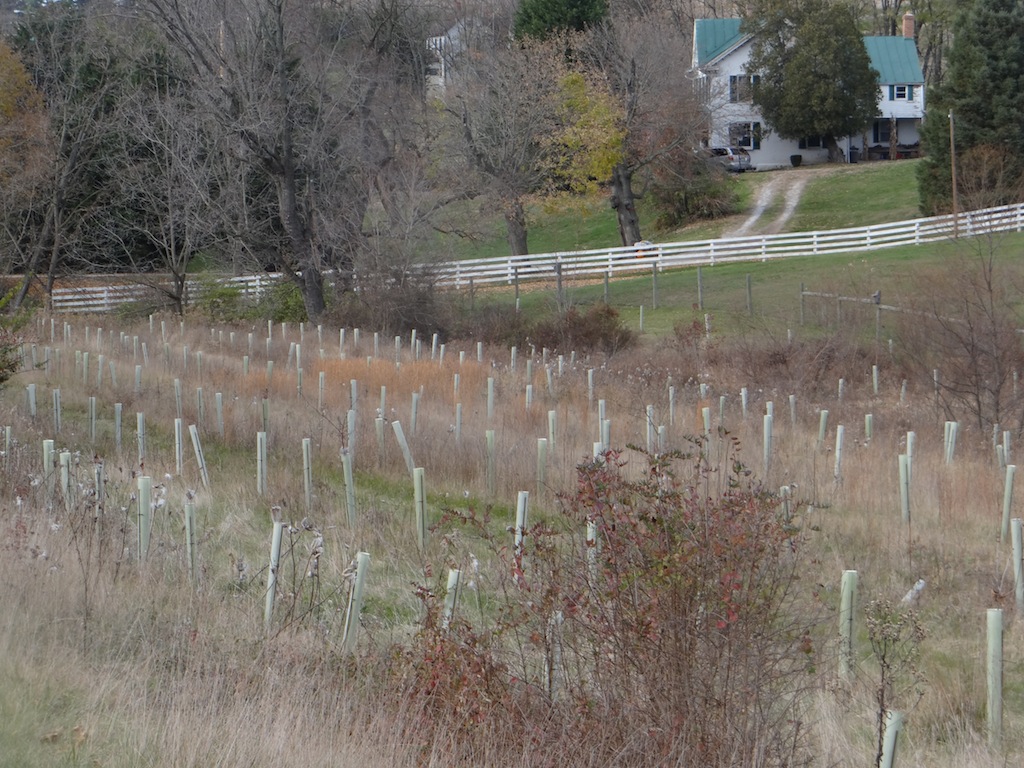As responsible stewards of the environment, we can actively influence water conservation. How much rain water falling on land is absorbed and utilized depends on the permeability of the soil and leaf cover. Areas laid bare to earth, such as construction sites cleared for industries, housing developments and roadworks as well as agricultural land quickly fall subject to erosion when heavy rains carry away the soil particles. These soil sediments clog local streams, pollute the water and kill aquatic life that need light and oxygen to survive. The water becomes unsuitable for drinking, recreation or industry.
With the passage of the Clean Water Act, monitoring of watersheds began in order to improve overall water quality in the nation. In Carroll County, the EPA places us in the Monocacy Watershed and tests the quality of our streams. Starting in 1996, reports indicated that suspended sediment and nutrients were a major issue for us.
One of the ways to address the sediment problem is to plant shrubs and trees in areas denuded of vegetation. Growing leaves buffer the impact of heavy rains on soils. Roots and plant debris settle out soil sediments as the runoff flows over and through those obstructions before reaching stream beds. The soil becomes more porous and filters out agricultural fertilizers like ammonium dissolved in water and phosphorus can now bond to soil particulates. Nitrates become nitrogen gas and carbon is sequestered in the ground. All these actions of tree/shrub buffers benefit the fish, crustaceans and other aquatic life by keeping the water cleared of unmitigated influxes of pollution laden sediment. Keeping a leaf canopy over streams cools the water—essential for most aquatic life in running water which die off when streams temperatures rise too high. Planting trees and deep-rooted shrubs along waterways also lessens erosion on stream banks.
You may have seen and wondered at all the closely planted trees with tree guards along certain roadways. Installing forestry buffers is a long term process which may take 15 to 20 years while waiting for tree crown closure before seeing maximum benefits accrue. The tree stock needs to be matched to the site and must be diverse enough to be resilient to pest and disease pressures. The seedlings are planted at high stocking rates—preferably about 400 trees per acre. With lower stocking levels, not enough trees survive. They die from weed (especially grass) competition, drought, deer browsing and mowing damage, sometime from insects. Invasive exotics also factor into reforestation efforts, many being pioneer species in cleared lands. . After five years, the plantings generally stabilize with about 50% of the initial planting still living with the addition of naturally regenerated volunteer seedlings. There seems to also be an increase in other native plant species able to gain a foothold from changed conditions on the site.
Carroll County had planted 100.10 miles of forest buffer by 2012, the 5th largest effort in Maryland. So far, the results have shown improvements in aquatic diversity, streambank stability and oxygenation. Pesticide effects have been ameliorated and nitrate/phosphate levels have improved on some sites. EPA testing has less suspended sediments as an issue in the Monocacy Watershed in Carroll. The larger problem has moved from point source to non-point sources like upstream urbanized areas with much more impermeable surfaces.
The Maryland Department of Natural Resources (DNR) began “Maryland Stream ReLeaf”—planting riparian (streams ,floodplains) areas on both public and private lands with the objective to reduce nutrient runoff to the Chesapeake and reduce nitrates by 60 to 90 percent. “Treemendous Maryland” is another program that exists to offer native trees and shrubs for planting on public lands: government sites, school grounds and other open spaces. Maryland Reforestation dictates that all highway construction that uses state funding has to mitigate forest disturbances, replacing cut or cleared areas acre for acre within a year of project completion within the same county of the affected watershed. Or, payment of $.10 per square foot affected goes into the Reforestation Fund. The state produces their native tree and shrub stock at the John S. Ayton Tree Nursery on the Eastern Shore to be used for reforestation, windbreaks, habitat improvement and recreational enjoyment.
For private homeowners who have a waterway on or adjacent to their property, the Potomac Watershed Partnership offers “backyard buffers”, bags of mixed native trees and shrubs suited to riparian condition (20-30 plants, 1—2 ft seedlings). Landowners with at least 10 acres of contiguous land are encouraged to enroll in a national forestry steward program with a certification . There are currently 1159 family forest owners—tree farmers in Maryland with 139K acres enrolled.




